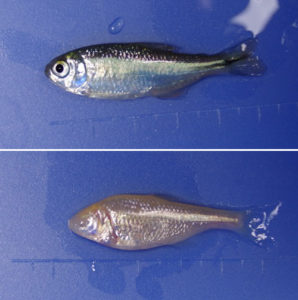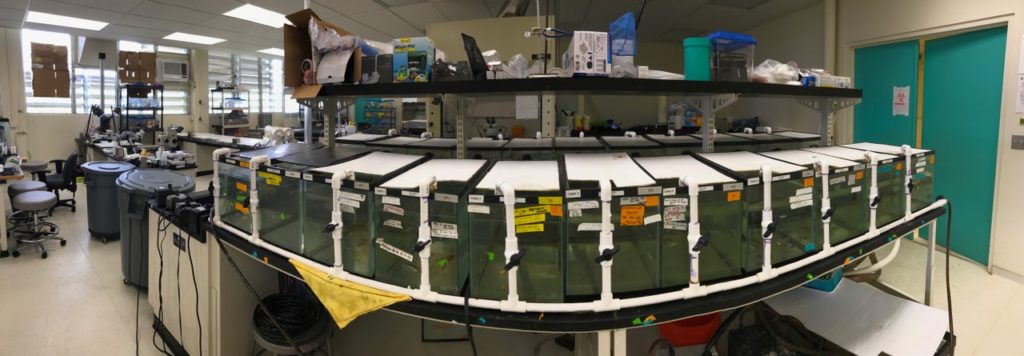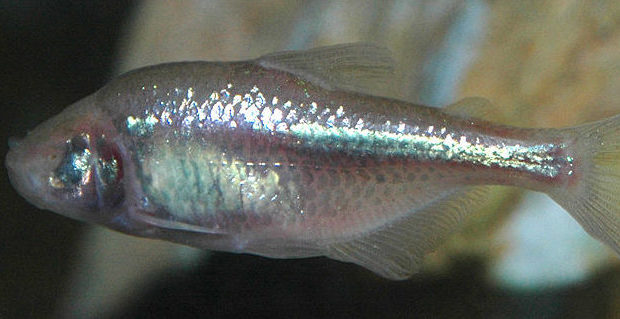Mexican Tetra come in two distinct forms: the river dwelling surface fish and the far stranger cavefish, which have no eyes, and are found in isolated caves in North America.
Surface fish are typical river fish, they school; sleep at night, pay well-balanced attention to food, predators and mates; and calmly hover while resting. In contrast, cavefish swim continuously; rarely interact with mates or sleep; exhibit repetitive behavior patterns like circling around at the middle of a water column; and they have higher levels of cortisol, the anxiety hormone, in their blood.

These symptoms have similarities with those exhibited by people diagnosed with ASD, characterized by having difficulty in socially interacting with others, hyperactivity, sleeplessness, imbalanced attention, and anxiety.
We do not believe that these shared behaviors between human and fish are at the same level of complexity but they seem to be driven by evolutionarily conserved neural wirings. For example, emotion-based behavior, attention, socialness, and sleep regulation are based on conserved neural networks in the brain, such as the cortical region, thalamus, hypothalamus and habenula.
Findings from our recent study suggest that behaviors that we have observed in cavefish are evolutionarily conserved between fish and human.
ASD-risk genes in cavefish
We made comprehensive surveys for cavefish orthologs (genes that share the same evolutionary ancestor) of human ASD-risk genes. By referring to these genes, we found some surprising similarities between cavefish and human.
Most of the orthologs of ASD-risk genes in cavefish and ASD patients shared the same polarities of gene expressions (up or down-regulation of gene expression). This level of similarity is very high compared with other ASD rodent models and neurons from induced pluripotent stem cells derived from ASD patients.

We also surveyed evolved genes in the cavefish lineage and found that ASD-risk genes evolved at twice the rate of other genes across the cavefish genome. Interestingly, ASD-risk genes are also positively selected in humans.
We are currently testing human ASD treatment drugs for fish social behaviors. We suggest that fish and human evolution share basic neural networks that generate ASD-like behaviors.
We and other groups believe that many cavefish behaviors are beneficial to finding food in the dark. But how did ASD-risk genes evolve in humans?
Human geneticist Polimanti et al. and others state that ASD is positively correlated with childhood intelligence, college completion, and years of schooling. Weiner et al. suggest many of ASD-risk genes are thought to provide cumulative effects that can lead to ASD. In other words, if you have a few ASD-risk mutations, you may have a better academic success; however, if you have mutations in many ASD-risk genes you have higher risk to express ASD.
ASD like behaviors in other species
Aside from cavefish, we do not know of any animal models that naturally show a series of autism-related behaviors. However, a recent study by Shpigler et al. suggested that ASD-risk genes are an evolutionary conserved gene set that regulates socialness in both honeybees and humans.
It is possible that animals may shift their variety of behaviors by modifying ASD-risk genes to adapt to novel environments.
We still have limited knowledge of the evolution of socialness and other behaviors in the context of adaptation because many of these behaviors are complex and are regulated by multiple genes. Based on the comparative studies between human, cavefish, and bee, it is possible that animals may shift their variety of behaviors by modifying ASD-risk genes to adapt to novel environments.
It will be interesting to test whether a set of ASD-risk genes are repeatedly targeted in other rapidly evolving species such as cichlid fishes in the lakes of East Africa, Trinidad guppies, and green anole lizards.
In the context of ASD-like behaviors, deer mice are known to show repetitive behavior under the novel environment. In addition, there are a number of domestic mutant mice including BTBR mice, and gene knock out-mice, which have lost the functions of ASD-risk genes. Many of them are characterized with their impairments in social interaction, lack of interest in cohorts, altered vocalization pattern, and stereotypic repetitive behaviors.
All of these are suggested as ASD-like behaviors by sharing the molecular and neural mechanisms to express ASD-like behaviors. However, these models do not overlap with systemic defects seen in ASD such as immune deficiency or impairment of digestive system. As we start characterizing that cavefish shows similar changes in both systems in addition to a set of ASD-like behaviors, we believe that cavefish can also fill a gap of systemic understanding of ASD, and can provide a foundation for new ASD therapy.

As for systemic understanding of ASD, we should note that some of domestic mutant mice show immune abnormality (e.x. BTBR mouse). It is not immune deficiency that ASD patients frequently have but some of these genetically modified mice indeed show systemic symptom.